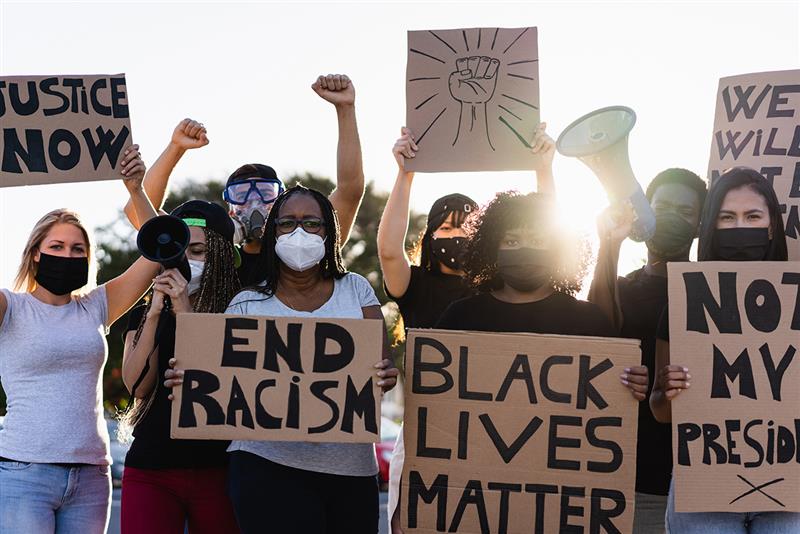As national unrest surrounding the death of George Floyd Jr. in Minnesota mounted daily this summer, the USC Division of Biokinesiology and Physical Therapy community held a virtual town hall on June 2, giving community members an opportunity to share their feelings and perspectives about systemic racism.
The meeting made it evident that the Division needed to do its part to confront any systemic racism within its community and educate the faculty, staff and students to be better advocates.
“Our students, faculty and staff recognized that we were in a once-in-a-generation moment,” Associate Dean James Gordon, EdD, PT, said. “It presented us with the opportunity — as well as the obligation — to confront the systemic racism that was exposed by these horrific murders of Black people.”
Strengthening efforts
It’s not that the Division wasn’t already steadfast in its commitment to diversity.
For nearly 10 years, since changing its admission process to a holistic approach, it had seen a steady increase in the admission of underrepresented minorities. Its admissions numbers were often double the national average of other physical therapy schools.
It had also forged a partnership with Xavier University of Louisiana, a historically Black college, to create a pipeline for students to earn their doctor of physical therapy at USC; launched a student-led effort, the USC Physical Therapy Multicultural Leadership Alliance, to raise awareness of the physical therapy profession in underrepresented minority communities; and held an open mic night focused on sharing stories of diversity and inclusion.
Still, the community knew it could be doing more, beginning what would become a months-long process to create a Division-Wide Comprehensive Anti-Racism Plan, which was finalized in late October.
“We could have allowed the momentum of the summer months to dissipate; the challenges presented by the pandemic certainly gave us plenty of excuse to do so,” Gordon said. “Instead, we have sustained this effort, and we have painstakingly written a consensus plan to make this a real part of our everyday mission.”
The plan
In addition to espousing support for the Black Lives Matter movement — “Our most urgent and immediate goal is to save Black lives – to put an end, once and for all, to the wanton disregard for Black lives that is deeply embedded in our society’s laws … ” — the plan lays out 12 objectives for the 2020-2021 academic school year.
The first objective was to create a new leadership position in the Division to focus on equity, diversity and inclusion. Associate Professor of Clinical Physical Therapy Didi Matthews, DPT, was appointed to this position, titled the Vice Chair for Equity, Diversity and Inclusion.
“It means a lot to me to be in this position,” Matthews said, explaining that, as someone who identifies as Black, she had not seen many that looked like her represented in her schooling or profession. “To see the support and decisive action we’re taking suggests to me that others also think that the status quo is not acceptable.”
The plan also called for the creation of a Division-wide council, called the Diversity, Anti-Racism, Inclusion and Community Engagement (DARIC) Council, to foster diversity in the recruitment and retention of faculty, staff and students; provide an inclusive, anti-racist environment where all community members are valued and feel welcome; and to promote population and health equity. This council is currently composed of six faculty members, three students and one staff member.
In addition to the Division-wide council, there are three sub-councils — admissions, faculty-staff support and student support.
The 2020-2021 plan’s objectives fall under the categories of program structure and leadership, culture and environment, faculty and staff development, curriculum, admissions, faculty/staff recruitment and retention, professional diversity, patient care and research.
Some of these objectives include providing an open, non-judgmental learning community-centered on themes of racism and social justice in health care education, practice, and research; updating curricula to incorporate health justice; making Division clinics more accessible and inclusive to a diverse population; and making the Division’s research culture more equitable and inclusive.
Beyond the Division
“We’re not going to be able to address every single issue in the course of one academic year,” Matthews explained. “The idea is for this plan to be living, evolving, sustaining for years to come. We’ll know it’s been a success if in the 2025-2026 academic year, we still have a plan that has assessed and revised, based on the benchmarks we’ve already met in previous years.”
Matthews said Division participation has really been inspiring.
“There’s been a lot of faculty and staff engagement during this time when there’s already a significant burden on faculty and staff because of the effects of COVID-19 on all of our work efforts,” Matthews said. “So I think when you add those two things together — the level of engagement tied with the challenges that faculty and staff are already facing — it’s really impressive.”
Gordon added, “I am exceedingly proud to be a part of a community that has stretched and extended itself in this way.”
While the objectives are meant to make the Division more welcoming to everyone, Matthews thinks it could have further-reaching impacts.
“It’s important that we do this work in the Division, but it’s also important that we push the status quo where we can outside the Division as well,” she said. “When we notice that there are things standing in the way of diversity, equity and inclusion outside the Division, including in healthcare generally, that we have the knowledge and tools to be able to address it.”
— John Hobbs


